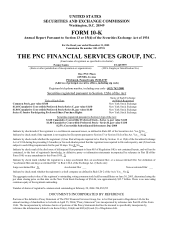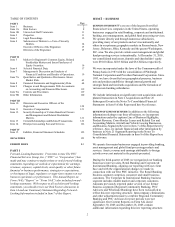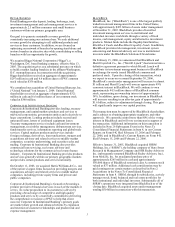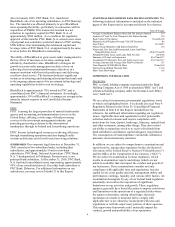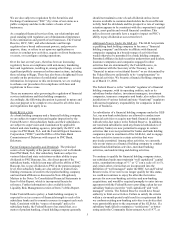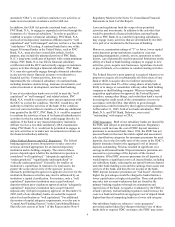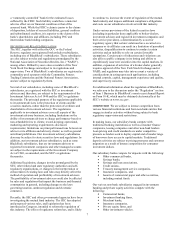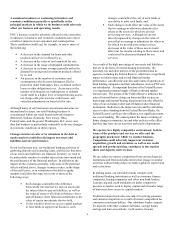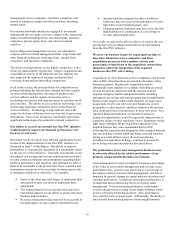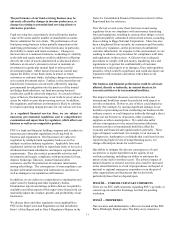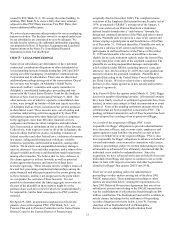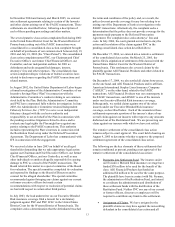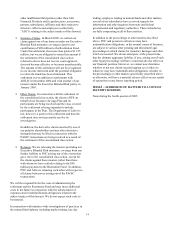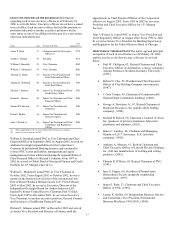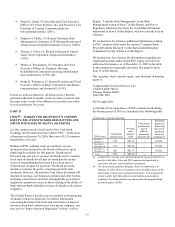PNC Bank 2005 Annual Report Download - page 6
Download and view the complete annual report
Please find page 6 of the 2005 PNC Bank annual report below. You can navigate through the pages in the report by either clicking on the pages listed below, or by using the keyword search tool below to find specific information within the annual report.
6
amended (“CRA”), we could not commence new activities or
make new investments in reliance on the GLB Act.
In addition, the GLB Act permits a national bank, such as
PNC Bank, N.A., to engage in expanded activities through the
formation of a “financial subsidiary.” In order to qualify to
establish or acquire a financial subsidiary, PNC Bank, N.A.
and each of its depository institution affiliates must be “well
capitalized” and “well managed” and may not have a less than
“satisfactory” CRA rating. A national bank that is one of the
largest 50 insured banks in the United States, such as PNC
Bank, N.A., must also have issued debt (which, for this
purpose, may include the uninsured portion of PNC Bank,
N.A.’ s long-term certificates of deposit) with certain minimum
ratings. PNC Bank, N.A. has filed a financial subsidiary
certification with the OCC and currently engages in insurance
agency activities through a financial subsidiary. PNC Bank,
N.A. may als o generally engage through a financial subsidiary
in any activity that is financial in nature or incidental to a
financial activity. Certain activities, however, are
impermissible for a financial subsidiary of a national bank,
including insurance underwrit ing, insurance investments, real
estate investment or development, and merchant banking.
If one of our subsidiary banks were to fail to meet the “well
capitalized” or “well managed” and related criteria, PNC
Bank, N.A. would be required to enter into an agreement with
the OCC to correct the condition. The OCC would have the
authority to limit the activities of the bank. If the condition
were not corrected within six months or within any additional
time granted by the OCC, PNC Bank, N.A. could be required
to conform the activities of any of its financial subsidiaries to
activities in which a national bank could engage directly. In
addition, if the bank or any insured depository institution
affiliate receives a less than satisfactory CRA examination
rating, PNC Bank, N.A. would not be permitted to engage in
any new activities or to make new investments in reliance on
the financial subsidiary authority.
Other Federal Reserve and OCC Regulation. The federal
banking agencies possess broad powers to take corrective
action as deemed appropriate for an insured depository
institution and its holding company. The extent of these
powers depends upon whether the institution in question is
considered “well capitalized,” “adequately capitalized,”
“undercapitalized,” “significantly undercapitalized” or
“critically undercapitalized.” Generally, the smaller an
institution’ s capital base in relation to its total assets, the
greater the scope and severity of the agencies’ powers,
ultimately permitting the agencies to appoint a receiver for the
institution. Business activities may also be influenced by an
institution’ s capital classification. For instance, only a “well
capitalized” depository institution may accept brokered
deposits without prior regulatory approval and an “adequately
capitalized” depository institution may accept brokered
deposits only with prior regulatory approval. At December 31,
2005, both of our subsidiary banks exceeded the required
ratios for classification as “well capitalized.” For additional
discussion of capital adequacy requirements, we refer you to
“Capital And Funding Sources” in the Consolidated Balance
Sheet Review section of Item 7 of this Report and to Note 4
Regulatory Matters in the Notes To Consolidated Financial
Statements in Item 8 of this Report.
Laws and regulations limit the scope of our permitted
activities and investments. In addition to the activities that
would be permitted a financial subsidiary, national banks
(such as PNC Bank, N.A.) and their operating subsidiaries
may engage in any activities that are determined by the OCC
to be part of or incidental to the business of banking.
Moreover, examination ratings of “3” or lower, lower capital
ratios than peer group institutions, regulatory concerns
regarding management, controls, assets, operations or other
factors, can all potentially result in practical limitations on the
ability of a bank or bank holding company to engage in new
activities, grow, acquire new businesses, repurchase its stock
or pay dividends, or to continue to conduct existing activities.
The Federal Reserve's prior approval is required whenever we
propose to acquire all or substantially all of the assets of any
bank or thrift, to acquire direct or indirect ownership or
control of more than 5% of the voting shares of any bank or
thrift, or to merge or consolidate with any other bank holding
company or thrift holding company. When reviewing bank
acquisition applications for approval, the Federal Reserve
considers, among other things, each subsidiary bank's record
in meeting the credit needs of the communities it serves in
accordance with the CRA. Our ability to grow through
acquisitions could be limited by these approval requirements.
At December 31, 2005, both of our bank subsidiaries, PNC
Bank, N.A. and PNC Bank, Delaware, were rated
“outstanding” with respect to CRA.
FDIC Insurance. Both of our subsidiary banks are insured by
the FDIC and subject to premium assessments. Regulatory
matters could increase the cost of FDIC deposit insurance
premiums to an insured bank. Since 1996, the FDIC has not
assessed banks in the most favorable capital and assessment
risk classification categories for insurance premiums for most
deposits, due to the favorable ratio of the assets in the FDIC’ s
deposit insurance funds to the aggregate level of insured
deposits outstanding. This has resulted in significant cost
savings to all insured banks. Deposit insurance premiums are
assessed as a percentage of the deposits of the insured
institution. If the FDIC assesses premiums for all deposits, it
would impose a significant cost to all insured banks, including
our subsidiary banks, reducing the net spread between deposit
and other bank funding costs and the earnings from assets and
services of the bank, and thus the net income of the bank.
FDIC deposit insurance premiums are “risk based”; therefore,
higher fee percentages would be charged to banks that have
lower capital ratios or higher risk profiles. These risk profiles
may take into account weaknesses that are found by the
primary banking regulator through its examination and
supervision of the bank. A negative evaluation by the FDIC or
a bank’ s primary federal banking regulator could increase the
costs to a bank and result in an aggregate cost of deposit funds
higher than that of competing banks in a lower risk category.
Our subsidiary banks are subject to “cross-guarantee”
provisions under federal law that provide that if one of these
banks fails or requires FDIC assistance, the FDIC may assess

